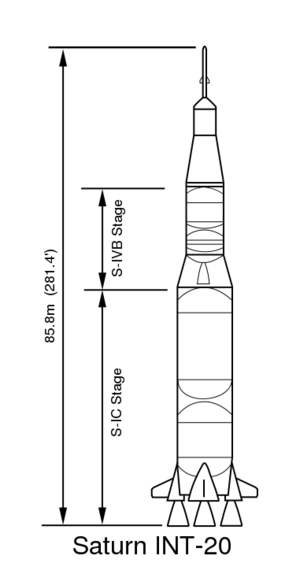- Saturn INT-20
caption = INT-20 configuration
name = Saturn INT-20
country-origin =United States
function = Manned LEOlaunch vehicle
manufacturer =Boeing (S-IC )
Douglas (S-IVB )
height = 85 m
alt-height = 281 ft
diameter = 10 m
alt-diameter = 33 ft
mass = 2,304,000 kg
alt-mass = 5,070,000 lb
stages = 2
LEO-payload = max 60,500 kg
alt-LEO =
status = Proposal
sites = LC-39,Kennedy Space Center
stage1name =S-IC
stage1engines = 3-5Rocketdyne F-1
stage1thrust = max 34.02 MN
alt-stage1thrust = max 7,648,000 lbf
stage1time = 212 seconds
stage1fuel =RP-1 /LOX
stage2name =S-IVB
stage2engines = 1Rocketdyne J-2
stage2thrust = 1 MN
alt-stage2thrust = 225,000 lbf
stage2time = ~475 seconds
stage2fuel =LH2 /LOX The Saturn INT-20 was a proposed intermediate payload follow-on from the Apollo
Saturn V launch vehicle. An interstage would be fitted on top of theS-IC stage to support theS-IVB stage, so it could be considered either a souped-upSaturn IB with a more powerful first stage, or a stubby, cut-down Saturn V without theS-II second stage.Three variants were studied, one with three F-1 engines in the first stage, one with four and one with five.
Performance
Without the S-II stage, which made up a large fraction of the mass of the Saturn V, the five-engine variant of the INT-20 would be seriously overpowered and accelerate substantially faster than the Saturn V. To avoid excessive aerodynamic stress in the low atmosphere three engines would be shut down 88 seconds after launch, with the remainder of the first-stage flight flown on only two engines. As a consequence the extra payload over the four-engine variant would only have been about one thousand pounds, and the extra cost and complexity of the fifth engine was unjustified.
The four-engine variant would launch with four engines firing and shut down two engines 146 seconds after launch. The remaining two engines would burn until first-stage shutdown 212 seconds after launch. This variant could put approximately 132,000 pounds into a 100
nautical mile (185 km or 115statute mile ) orbit, versus around 250,000 pounds for the three-stage Saturn V.The three-engine variant would burn all three engines up to first-stage shutdown at 146 seconds after launch. This variant could put approximately 78,000 pounds of payload into a 100 nautical mile (185 km) orbit, around twice the useful payload of the Saturn IB.
Both three- and four-engine variants would therefore have provided useful payload capacities intermediate between the Saturn IB and Saturn V, and re-using Saturn V components would reduce costs and simplify ground operations compared to building an entirely new launcher in that payload range.
References
* [http://www.astronautix.com/data/satvint.pdf Final Report - Studies of Improved Saturn V Vehicles and Intermediate Payload Vehicles (PDF format)] , October 7th 1966
* [http://www.astronautix.com/lvs/satint20.htm Saturn INT-20 (Astronautix)]
Wikimedia Foundation. 2010.

